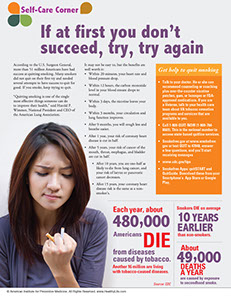SYMPTOM CHECKER
CONDITIONS
Male
Female
Child
Arm, Hand & Shoulder Concerns
Legs & Feet Concerns
Dental & Mouth Concerns
Ear & Nose
Eye Conditions
Head Conditions
Arm, Hand & Shoulder Concerns
Legs & Feet Concerns
Front
Back
Arm, Hand & Shoulder Concerns
Dental & Mouth Concerns
Ear & Nose
Eye Conditions
Head Conditions
Arm, Hand & Shoulder Concerns
Dental & Mouth Concerns
Ear & Nose
Eye Conditions
Head Conditions
Front
Back
Arm, Hand & Shoulder Concerns
Neck Links
Head & Neck Concerns
Arm, Hand & Shoulder Concerns
Neck Links
Head & Neck Concerns
Front
Back
Online Clinic
Wise Healthcare
If at first you don’t succeed, try, try again
Print on Demand
According to the U.S. Surgeon General, more than 51 million Americans have had success at quitting smoking. Many smokers did not quit on their first try and needed several attempts to have success to quit for good. If you smoke, keep trying to quit.
“Quitting smoking is one of the single most effective things someone can do to improve their health,” said Harold P. Wimmer, National President and CEO of the American Lung Association.
It may not be easy to, but the benefits are well worth it:
• Within 20 minutes, your heart rate and blood pressure drop.
• Within 12 hours, the carbon monoxide level in your blood stream drops to normal.
• Within 3 days, the nicotine leaves your body.
• Within 3 months, your circulation and lung function improves.
• After 9 months, you will cough less and breathe easier.
• After 1 year, your risk of coronary heart disease is cut in half.
• After 5 years, your risk of cancer of the mouth, throat, esophagus, and bladder are cut in half.
• After 10 years, you are one-half as likely to die from lung cancer, and your risk of larynx or pancreatic cancer decreases.
• After 15 years, your coronary heart disease risk is the same as a non-smoker’s.
Get help to quit smoking
• Talk to your doctor. He or she can recommend counseling or coaching plus over-the-counter nicotine patches, gum, or lozenges or FDA-approved medications. If you are a Veteran, talk to your health care team about VA tobacco cessation programs and services that are available to you.
• Call 1-800-QUIT-NOW (1-800-784-8669). This is the national number to access state-based quitline services.
• Smokefree.gov at www.smokefree.gov or text QUIT to 47848, answer a few questions, and you’ll start receiving messages
• Smokefree Apps: quitSTART and QuitGuide. Download these from your Smartphone’s App Store or Google Play.

This website is not meant to substitute for expert medical advice or treatment. Follow your doctor’s or health care provider’s advice if it differs from what is given in this guide.
The American Institute for Preventive Medicine (AIPM) is not responsible for the availability or content of external sites, nor does AIPM endorse them. Also, it is the responsibility of the user to examine the copyright and licensing restrictions of external pages and to secure all necessary permission.
The content on this website is proprietary. You may not modify, copy, reproduce, republish, upload, post, transmit, or distribute, in any manner, the material on the website without the written permission of AIPM.
2021 © American Institute for Preventive Medicine - All Rights Reserved. Disclaimer | www.HealthyLife.com
















































